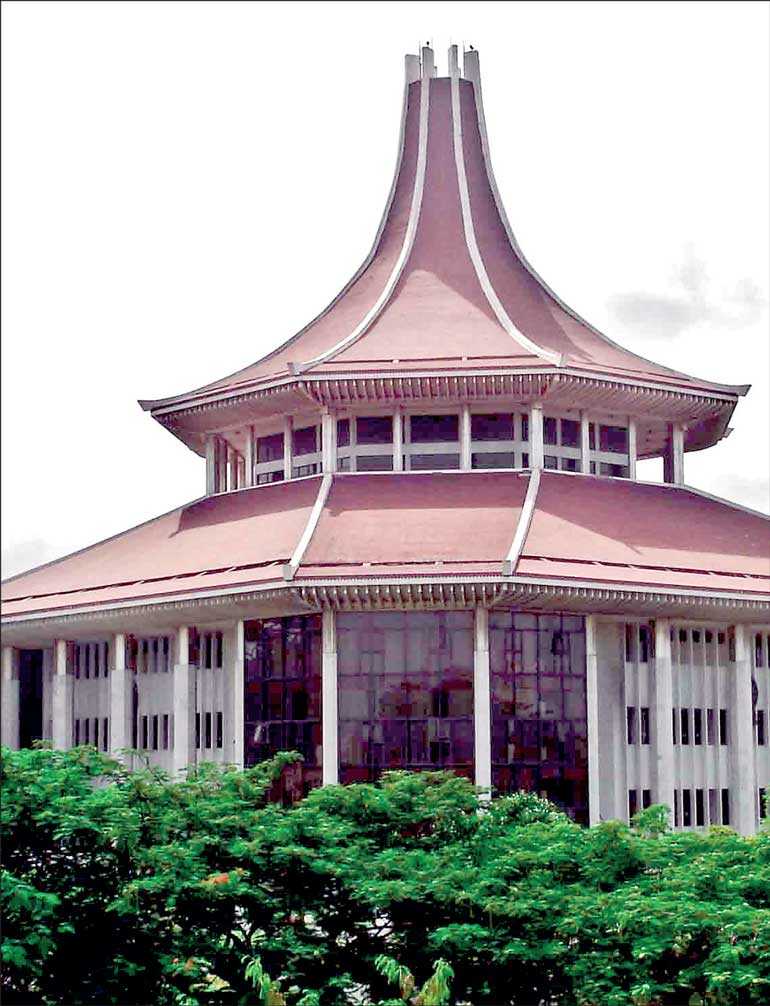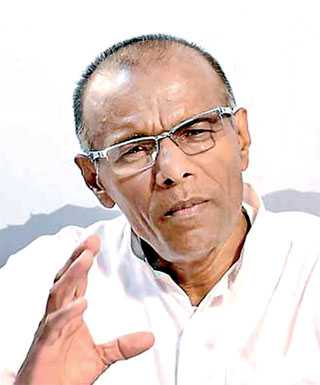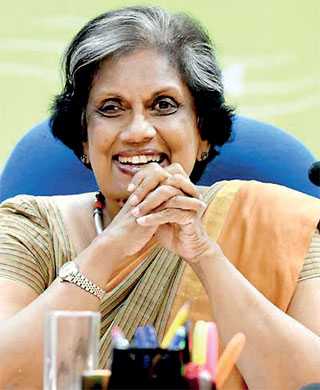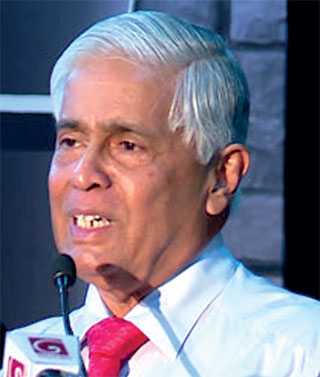Thursday Apr 03, 2025
Thursday Apr 03, 2025
Friday, 29 March 2019 00:10 - - {{hitsCtrl.values.hits}}

The Supreme Court has issued an order barring Nagananda Kodithuwakku, Attorney-at-Law and public interest litigation activist, who has entered the political arena of Sri Lanka as a prospective presidential candidate, from practicing as a lawyer for three years. I think it is important that we assess Kodithuwakku’s role in the light of this incident. 
Nagananda was an ex-revenue officer of the Customs Administration of Sri Lanka. As a Customs Revenue Officer, he proved to be a special kind of a person who never bowed down to powerful politicians. I knew him closely for a long time. During the reign of JR Jayewardene, he was interdicted from Customs Service for a longer period, due to an incident in which he had detected a fraud involving the importation of a brand new Benz car by a leading crony of the then-Government, under the pretext of importing a used vehicle. Nagananda maintained an uncompromising policy against the culprit, which eventually resulted in him being interdicted.
He was still on interdiction when Chandrika Kumaranatunga came to power in 1994. It was I who introduced him to Chandrika. He performed a strategic role, which no ordinary person would have undertaken, during the first Presidential Election of Chandrika Kumaranatunga. Chandrika knew that his interdiction was unreasonable and she assured him that he would be reinstated in service, following her victory of the Presidential Election.
Though Chandrika had a genuine interest in doing justice to Kodithuwakku, there was an influential clique among her close confidantes who were strongly against Kodithuwakku being reinstated in the Customs Service. Balapatabendi, Secretary to the President, was one of them. Perhaps, Balapatabendi was angry with Kodithuwakku over a report published in the Ravaya newspaper, about the importation of a stock of footwear by his son, which had been cleared without paying customs duty. Balapatabendi might have thought that Kodithuwakku had leaked out the information about this transaction to Ravaya.
Reporting of this issue in the Ravaya was not to the liking of the President too. She summoned me, and blamed me for publishing the article. She told me that she knew Bala from the time she worked at the Land Reforms Commission; he is an extremely a honest person; so she had called Bala and had told him that the Ravaya may have published the article on wrong information provided by somebody, without checking its accuracy. Having said that, she told me another interesting story about taking legal action against the publication of the article. According to what she told me, she had advised Balapatabendi to file a case against me, and had assured him that she would defray all legal expenses; but, he had not taken legal action, proving that the Secretary to the President was scared of Victor Ivan.
Once she finished making her comments, I told her that “Though I do not know your subject, I am sure that I know my subject (journalism) very well; also, I have a very good knowledge about my informants; I know very well who should be and who should not be trusted.”
Chandrika’s ungratefulness
 |
Attorney at Law Nagananda Kodithuwakku |
 |
Former President Chandrika Bandaranaike Kumaratunga |
 |
Former Chief Justice Sarath N Silva |
I came to know, through unofficial sources, of the decision taken by Chandrika not to reinstate Kodithuwakku.The report published in the Ravaya newspaper too, might have caused this decision, to a certain extent. However, I was posted of the decision at last, through one of her secretaries, who is none other than the former Chairman of State Timber Corporation who was taken into custody recently, together with the Chief of Staff of the incumbent President, while they were accepting a bribe of Rs. 20 million. Maybe President Chandrika did not have the guts to tell it to me direct. The secretary talked to me over the phone, almost apologetically.The brief of what he said is as follows. “Madam is very keen in reinstating Kodituwakku. But, the senior officers of the Ministry of Finance were strongly against it. Understandably, it would not be possible for Madam to make them angry as the Ministry of Finance is coming under her purview. So, Madam asked me to tell “Athula Ayya” about her inability to reinstate Kodituwakku back in his post.” In reply, I told him to tell madam that “I too, would become an adversary of the Government the day Kodituwakku decides to go against her.” It appeared that the secretary was flabbergasted by my reply. He said many things to comfort me.
However, Kodithuwakku was reinstated in service later, by S.M.I. Senarathna, the Chief of Customs. It was initiated without seeking the approval of the President. Though Senarathna was an officer, very close to the President, Harry Jayawardena had threatened a team of Customs Officers, pointing a pistol at them, on an occasion they had gone to his residence in connection with an investigation initiated by Customs against a company belonged to Harry Jayawardena. On this issue, the President openly took the side of Harry Jayawardena. However, the Chief of Customs, contrary to the stand taken by the President, strongly appeared for the defence of the Customs Officers. Later, this dispute became a protracted issue and as a result, a Customs officer was murdered. In this backdrop, the Chief of Customs intervened and got Kodithuwakku to flee to the UK for his defence.
Before leaving to the UK, Kodithuwakku came to my office to inform me about his departure. I had a good knowledge about the assassination of the Customs Officer. At this meeting, he shared with me the latest information about the murder. A statement made by him on this incident, before he left Sri Lanka, was published in the Ravaya newspaper.
During his stay in the UK, Kodithuwakku was employed as a lawyer there. As far as I know, he returned to Sri Lanka during the second term of President Mahinda Rajapaksa. Thereafter, he returned to Sri Lanka from time to time, and on some occasions he used to pay a visit to me. He used to appear for Customs cases when he was in Sri Lanka. He got involved in a big dispute with Mohan Peiris, the Attorney General. Gradually, he became a public interest litigation activist and a prospective candidate for Presidential Election 2020. He can be considered a person who has made the optimum use of social media for his campaigns. This has resulted in making him an accepted and popular character among those who are connected to social media.
Fighting with the Judiciary
It was a Supreme Court Judge who had filed the case against Nagananda in the Supreme Court. The incident pertained to this inquiry had occurred during a case taken up in 2015, before a panel of judges, of which the Judge who filed the case against Nagananda was also a member in his capacity as the then President of the Court of Appeal (CoA). On that occasion, Attorney-at-Law Kodithuwakku, appearing for the Complainant, had objected to the case being heard by that Judge and had requested the case be transferred to a different Court. If there are reasonable grounds, not only an Attorney-at-Law, an Accused too has the right to raise objections. But there is a way to do that. Objections, if any, must be raised in proper and decent manner, keeping to the accepted norms and the culture of the Judiciary. In this instance, I do not know how Kodithuwakku would have conducted himself in making the objection.
A person who chooses to fight against the Judiciary is most likely to get trapped in a situation involving a Contempt of Court. As the law of Contempt of Court in Sri Lanka has not been interpreted with a formal Act, it will not be an easy task to fight against a charge on Contempt of Court. Facing a charge of Contempt of Court can be considered falling into a trap, not so easy to escape. Those who choose to fight with the Judiciary must be aware of it. Public media had reported that Nagananda was prepared to express his regret to the Supreme Court Judge who lodged the complaint against him. The plight of Nagananda in this case is more or less similar to that of S.B. Dissanayake.Whatever the reason, Nagananda also had done the same thing that S.B. Dissanayake did. S.B. Dissanayake admitted his fault. There were instances when Mahatma Gandhi had refused to pay even a simple and an affordable fine and opted to go to jail. Socrates, being faithful to his principles, chose to face death penalty when he could have saved his life by paying a big fine.
Courage and determination can be considered two important elements that a fighter should possess. Kodithuwakku has both these qualities. One who possesses these two qualities can become a defiant fighter, but not a successful fighter.There is a third quality required to be a successful fighter. That is the strategic wisdom. It is the strategic wisdom that enables the fighter to understand the main challenges, set priorities, plan the way to fight, collect objective facts required for the fight, decide the appropriate time for fighting, and times when one should abstain from fighting, and to make a proper assessment of the results generated.
It is not a wise move to adopt a policy of fighting against all challenges at once. It might invariably create a situation in which all opponents will get together and form themselves into a formidable force against the fighter, and make him an easy prey. The most intelligent and the best strategic approach would be to select only one challenge at a time that one can be sure of winning, and launch the fight against it. It was only after that the other challenges should be taken up, one or two issues at a time and pursue the fight against them. Military leaders intent on capturing countries will not fight against many countries simultaneously. What they do is to capture one. and then invade another. and so on. This can be considered the biggest weakness inherent in the strategy of Nagananda. His line of attack has been to fight against all challenges at once. Especially when a person resolves to fight against the Judiciary, he should have a good strategic road map. Besides that, he must have a good discipline and self restraint to pursue the struggle with due respect to the other party or parties involved.
My experiences
I am a person who had had a major conflict with the Judiciary. It can be considered the biggest conflict a civilian had entered into with the Judiciary in Sri Lanka’s history of Judiciary. It can also be considered a conflict which attracted the attention of the international legal community.
But it was not a spurious conflict based on unauthentic facts, initiated with the object of boosting the image of the fighter. On the contrary, it can be described as a genuine struggle based on reasonable and realistic facts, and initiated in a small scale, and had gradually developed into a large-scale fight, gathering momentum and the support of several parties. Though it was initiated by me alone, it can be described as a struggle which, in a certain stage of its development, had received the support and the sympathy of the community of lawyers and judges as well as the general public.
The origin of this conflict can be traced back to an article I had published in the Ravaya newspaper on an incident in which a Magistrate had sexually harassed a woman, a case related to her being heard by him, and the lackadaisical policy adopted by the authorities in this regard. The disappointment and serious shock that was caused in me, due to the nature of the issue, and the careless attitude of the authorities, prompted me to launch this struggle. The Magistrate in question happened to be a clerk of the Sri Lanka Insurance Corporation before he joined the Judiciary, and had been dismissed from the service on account of his involvement in a fraud involving an insurance claim of a third party. He had not disclosed his infamous career history when he joined the Judiciary.
When this incident was published in the Ravaya newspaper, the Magistrate in question met Sarath Silva, the Attorney General who had close connections with him. On advice of the Attorney General, he had given a statement against me to the Criminal Investigations Department, to institute a criminal defamation case against me. When two investigators of the Criminal Investigations Department came to me to get a statement from me, I produced all information that I had discovered up to then about the conduct of the Magistrate, including a photocopy of a document confirming his dismissal from Sri Lanka Insurance Corporation, his previous employer, over a deliberate financial fraud of cheating a third party. In addition, all information that I had of the women, the victim of the case were also provided to them.
Though the investigation was begun against me, it eventually ended up being an investigation against the Magistrate who made the complaint. The investigating officers, in addition to questioning and obtaining a statement from the woman who was the victim of the incident, had obtained relevant information from Sri Lanka Insurance Corporation about his dismissal from service.
In this backdrop, in which the Complainant had become an accused, the Criminal Investigations Department had sent its report of the investigation to Attorney General Sarath Nanda Silva for his advice. I was tacitly but eagerly waiting to see the course of action that the Attorney General would be taking against this fraudulent and rapist Magistrate.
When it became evident that the Attorney General was stalling and not going to take any action, I complained the matter to Professor G. L. Peiris , the then-Minister of Justice and he, in turn requested the Attorney General to submit a report on this issue. Consequently, a confidential report was sent to the Minister. I managed to obtain a copy of this report, and was shocked to see the contents therein. The undisguised contempt I felt about the Attorney General was beyond expression. It may be possible that a rape can be variously interpreted and ignored, but how can we recognize an Attorney General, who does not consider a culprit, who had been found guilty of a financial fraud and dismissed from service, joining the Judiciary, a serious and unpardonable offence, as the Attorney General of the country?
After reading the confidential report of the Attorney General, my observation on him was that he must be a low and despicable person. This led me to find out more about Sarath Silva, the Attorney General. As a result, I was able to surface two horrendous incidents relating to him, which could be proved with evidence. Of them I have published only one incident.
The story I published covered the case filed by Jayasekara, a Chemical Engineer, against his wife, making both his wife and Sarath Silva, co-respondents of the case and the procedure implemented in hearing the case which was contrary to the law, by the Attorney General Sarath Silva, with the connivance of the District Judge Upali Abeyratna. As I have published this episode before, I do not wish to repeat it here. Of the two incidents, the most horrendous is the one that I had not published. Had it been published, not only Sarath Silva, but also an innocent family connected to that incident might have been ruined completely. It was not published not because there was no evidence, but out of concern of the fate of the other party.
On account of the persistent pressure that I applied against the above two Magistrates and the Attorney General Sarath Silva, The President of the Bar Association of Sri Lanka requested the Chief Justice to appoint a Committee to investigate into this matter. Consequently, the Chief Justice was compelled to appoint two tripartite investigating committees comprised of the judges of the Appeal Court. The Investigating Committee appointed to inquire into the charges against Lenin Rathnayaka found him guilty for all charges put forward by me. District Judge Upali Abeyratna admitted the fault without facing the inquiry.
After the two Magistrates were found guilty by two tripartite investigating committees, I made a complaint to the Supreme Court requesting to strike the name of Sarath Silva, the Attorney General, off the Roll of Attorneys–at- Law, under the Clause 2 of the Judicial Act , on account of the fact that he had committed a grave offence by defending Magistrate Lenin Rathnayaka, and covering up his malpractices, knowing very well that the latter had been found guilty of all charges levied against him. A similar complaint was made to the Supreme Court by the Engineer Jayasekara against Sarath Silva, Attorney General based on his case.
The Supreme Court held a collective meeting to discuss whether these two complaints should be taken up for trial. In that meeting only two judges had objected to the holding of an investigation against the Attorney General. Consequently, an investigating committee comprised of Justice Ameer Ismail, Justice Shirani Bandaranayake, and Justice Dr. Mark Fernando was appointed. Justice Ameer Ismail was made in charge of the inquiry into the complaint I made, while Justice Shirani Bandaranayke was in charge of the inquiry into the complaint made by Jayasekara. Dr. Mark Fernando was the officer in charge of coordination and management of both cases. G. P.S. Silva, the Chief Justice went on retirement when these two inquiries against Attorney General had been commenced and were in progress.
President Chandrika Bandaranaike Kumaratunga, coming to the rescue of Sarath Silva, her close confidante, who had found himself gripped in a strangulated condition with no escape, made him the Chief Justice, ignoring the investigations initiated by the Supreme Court and was in progress. I expressed my protest and condemnation of this appointment by publishing the picture depicting the swearing in of Sarath Silva as the new Chief Justice in the presence of President Chandrika Bandaranaike Kumaratunga, upside down against a black background, with the text of the report printed in reverse white in the front page of the Ravaya Newspaper. Thereafter, three of us filed fundamental rights cases challenging the appointment of the Chief Justice. In view of the fact that Chief Justice himself was deciding the panel of judges of this case, we knew for sure that we can never win the case. However, our intention was to continue our struggle and keep it alive, rather than leaving it to be abandoned half way through its progress, following his appointment to the post of Chief Justice. Several Bar Associations including the International Bar Association got together and made arrangements to nominate a retired Chief Justice of Kerala, India, as an observer of this trial.
Thereafter, I took part in two unsuccessful efforts for impeaching the Chief Justice. Besides that, I authored and published a book titled “Unfinished Struggle”, highlighting the contemptible role of Sarath Silva the Chief Justice. The book was published when he was the sitting Chief Justice. It became a popular publication both locally and internationally.
I must state that the role played by political parties and the media of the country in this dispute involving Sarath Silva was equally contemptible as Sarath Silva himself.
Not only the two main political parties, the parties like JVP and Hela Urumaya too, resorted to reaping maximum benefits for their advantage from this crisis, like flies feeding on a decomposed corpse, thereby reinforcing his survival. The owners of many media organisations made this crisis an opportunity to settle their legal suits with the support of the Chief Justice. The status of Sri Lanka would not have been as wretched as it is today if the role played by political parties and media in this crisis had been different.